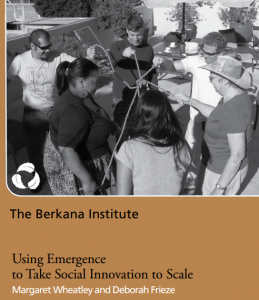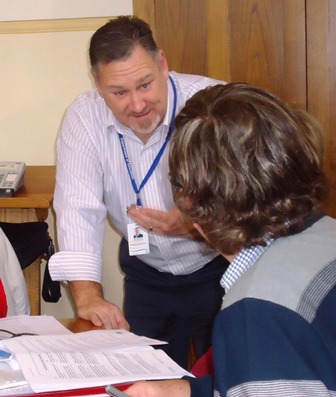The challenge – and probletunity that I’d like to share with you comes from a sustained 8 months of work here in Tasmania, where I support 21 schools, primary, secondary and colleges, from K-year 12. The probletunity is around leading and supporting schools in this work; leading them with a real activator mindset, as more than a facilitator of learning.
We began the first of our 6 full day workshops in April, with a 2 day institute for school leaders from all 21 schools, a cohort of around 70 people. We insisted that schools send principals, as well as a team of leaders who would be responsible for leading the NPDL work in each school. This was a high risk – high reward strategy.
The risk – School principals are incredibly busy, so to mandate their attendance created at least a couple of pressure points – the PL had to be compelling, engaging and relevant, as well as clearly linking to their school reform agendas and plans.
The reward – From our point of view, we knew that if we did not engage strongly with principals, as lead learners, to use a Vivianne Robinson term, that the likelihood of successful implementation action and sustainability was negligible. The literature in both education and the corporate world emphasizes the importance of leaders inspiring and guiding initiatives and we know that leadership plays a central and critical role in implementing change.
So our first 2 days were really heavy – examining the NPDL frameworks and documents – which had not been finalised at that stage, and we followed with a third day in mid-June, after the Global institute in Seattle. Feedback from school leaders was mixed – the most common being requests for real clarity around documentation, expectations and examples of real live deep learning. Whilst we had made some strong inroads into the work, we still hadn’t really nailed it…..
I was left scratching my head. In our NPDL cohort we have the bell curve we see in any classroom – innovators, early adopters, fence sitters, late majority and those grappling furiously to connect the work into context and move forward.
My challenge – my probletunity – was finding how to meet the needs of such a diverse class – to differentiate the learning. It was at this time I recalled a framework I have used to underpin a number of long term PL programs. It comes from the good people at the Berkana Institute, an NGO who are about creating community partnerships.
Their framework is deceptively simple. Until you put it into practice.
It consists of 4 stages that aren’t necessarily linear, or discrete, and the stages are:
Name – Connect – Nourish and Illuminate.
 To give you a brief summary of my interpretation of the framework:
To give you a brief summary of my interpretation of the framework:
Pioneering leaders often act in isolation, unaware that their work has broader value. They are too busy to think about extending their work, and too humble to think that others would benefit. So Naming them up in fact helps them connect (stage 2) and this Connection is all about building relationships, finding common threads, practices needs and challenges.
Communities of practice need many different resources. Two have resonated for me in practice:
The first is learning. Learning what works, learning from experience and Ensuring that learning IS the work.
The second, and most significant dimension of connection and nourishment is around relationships. The interactions and exchanges among pioneering leaders themselves. Leaders and teachers need and want to share their practices, experiences and dreams. Creating opportunities and resourcing people so they can learn together has become a powerful way to nourish their efforts.
So name – connect – nourish – the fourth stage is Illuminate.
It takes time, attention and a consistent focus for people to see different approaches for what they are: examples of what’s possible……….of what our new world could be like.
Illuminating, making visible, celebrating and sharing the stories of pathfinding efforts is a critical part of building a culture of success.
So as this framework for supporting emergence of new practice reoccurred to me, it shifted and concentrated my focus and gave me a new lens under which to reframe the work supporting our schools.
We undertook some data gathering – using an online survey to ask school to prioritise their needs and focus areas. At the same time I visited each school and had significant conversations with leaders about the place of NPDL – digging deep to find the fit with their school improvement priorities. I was connecting and nourishing the work.
The fit was there, in every case – it just took some effort to find. We had many “a ha” moments. These conversations were critical to building individual and shared understanding of this work. These individual conversations were critical to connecting.
With our resource documentation pack released, expectations defined and a growing understanding of what this work was really about in each of our school contexts, connections between schools began to emerge.
Our data gathering allowed me to continue to find and share common aspirations, doubts and possible shared focuses, because I had a view from both the dance floor and the balcony. Again there was that idea of nourishment though thread finding and connecting.
Across days 4 and 5 of our program, we instigated a series called short stories about shift. In 10 minute snapshots, schools shared their journey, successes, connections and challenges with our cohort. Not only were we hearing and seeing, naming and connecting, but we were illuminating, in a trusting and safe environment, and in doing so, building shared practice – using the group to change, or build and empower the group, as Michael Fullan might say.
Sharing short stories about shift has been the singularly most powerful factor in building confidence, and creating authentic links between schools, leaders and teachers.
As I look back on the NCNI framework, it’s very much about emergence – discovering shared meaning and purpose, developing new practices together, and then making these practices the norm….
So what have I learned over the course of leading this work?
- This work is about simplexity – “Finding the smallest number of high-leverage, easy-to-understand actions that unleash stunningly powerful consequences.” (Fullan, 2010a, p.16).
- Again and again, we reiterate to schools and leaders; this is long term work- there’s no state of being behind, or failing to achieve – this is doable, but it’s challenging, as any change leadership is – so we have to explicitly remind and support all leaders to bring their A game in strategic change leadership – because they will need it
- At a personal level, my role is to activate, exploit, pursue and manufacture connections between and among schools, and school leaders.
- And finally, we want to embed this work – to ensure that Deep Learning is a part of the DNA of every school, and every learner…it has to be inseparably linked to each school’s improvement plans so that we can produce sustainable and sustained shift, away from the rhetoric and into tangibly measurable impact of deep learning on teachers, learners and community.
My grandfather was a builder and a huge influence on my life, so I often try to simplify to “build metaphors” so in this case,
Leading this work comes back to 3 builds, if you like:
building relationships,
building understanding,
and building capacity
and for me the Berkana framework Name-Connect-Nourish-Illuminate provides a scaffold for my practice as a leader of change, and explicitly and effectively helps me grow the emergence of a new community of practice around New Pedagogies for Deep Learning.
It has turned a potential program-halting challenge into an opportunity for growth, reinvention and Education Plus, helping me to model Ethical Entrepreneurialism in a practical, authentic and concrete leadership role.
As leaders of this work, I think we have to push boundaries, but we have to also negotiate system needs and mandates. The delicate work of making NPDL accessible for all will continue to challenge us. So I want to close by commending the Berkana framework for emergence to you as one tool that may help us all to navigate this journey.
references:
Berkana Emergence Framework: http://berkana.org/berkana_articles/lifecycle-of-emergence-using-emergence-to-take-social-innovation-to-scale/
When Change Has Legs. David N. Perkins and James D. Reese http://www.ascd.org/publications/educational-leadership/may14/vol71/num08/When-Change-Has-Legs.aspx
the framework in action: www.thesowhatproject.com

